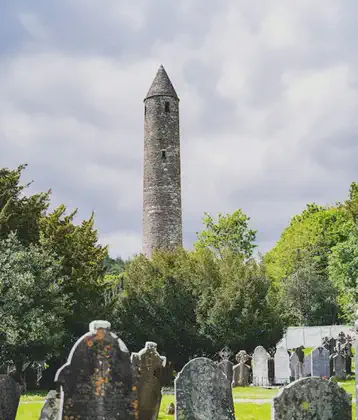On June 05, 1868 in Celtic History
James connolly, irish revolutionary hero, born in edinburgh scotland.

James Connolly (Irish name: Séamas Ó Conghaile or Ó Conghalaigh; June 05, 1868 ? May 12, 1916) was a Scottish-Irish socialist leader. He was born in Edinburgh, Scotland, to Irish immigrant parents. He left school for working life at the age of 11, but despite this he would become one of the leading left-wing theorists of his day. Though proud of his Irish background he also took a role in Scottish politics. In addition, he studied the neutral international language, Esperanto.
He is believed to have joined the British Army at the age of 14, and was stationed in Dublin where he would later meet his wife. When his regiment was sent back to Britain he went absent and never returned. He was never posted as absent because the regimental records went missing during the relocation. It is believed he served approximatley seven years in the British Army.
By 1892, he was an important figure in the Scottish Socialist Federation, acting as its secretary from 1895, but by 1896 he had left the army and established his Irish Socialist Republican Party (ISRP). While active as a socialist in Great Britain Connolly was among the founders of the Socialist Labour Party which split from the Social Democratic Federation in 1903. He was right hand man to James Larkin in the Irish Transport and General Workers Union. In 1913, in response to the Lockout, he founded the Irish Citizen Army (ICA), an armed and well-trained body of labour men whose aim was to defend workers and strikers, particularly from the frequent brutality of the Dublin Metropolitan Police. Though they only numbered about 250 at most, their goal soon became the establishment of an independent and socialist Irish nation. He founded the Irish Labour Party in 1912 and was a member of the National Executive of the Irish Labour Party when he was executed in 1916.
Connolly stood aloof from the leadership of the Irish Volunteers. He considered them too bourgeois and unconcerned with Irelands economic independence. In 1916 thinking they were merely posturing, and unwilling to take decisive action against Britain, he attempted to goad them into action by threatening to send his small body against the British Empire alone, if necessary. This alarmed the members of the Irish Republican Brotherhood, who had already infiltrated the Volunteers and had plans for an insurrection that very year. In order to talk Connolly out of any such rash action, the IRB leaders, including Tom Clarke and Patrick Pearse, met with Connolly to see if an agreement could be reached. It has been said that he was kidnapped by them, but this has been denied of late, and must at some point come down to a matter of semantics. As it was, he disappeared for three days without telling anyone where he had been. During the meeting the IRB and the ICA agreed to act together at Easter of that year.
When the Easter Rising occurred on April 24, 1916, Connolly was Commandant of the Dublin Brigade, and as the Dublin brigade had the most substantial role in the rising, he was de facto Commander in Chief. Following the surrender he was executed by the British at Kilmainham Gaol in Dublin, although he was so badly injured from the fighting that he was unable to stand before the firing squad and was therefore shot in a chair. He was survived by his wife and numerous children.
His legacy in Ireland is mainly due to his contribution to the nationalist cause and his Marxism has been largely overlooked by mainstream histories (although his legacy as a socialist has been claimed by the Labour Party, the Communist Party of Ireland, the SWP, the Socialist Party and a variety of other left-wing and left-republican groups). However, despite claims to the contrary, Connollys writings show him to be first and foremost a Marxist thinker. In several of his works he rails against what he calls the bourgeois nationalism of those who claimed to be Irish patriots.
Connolly was among the few left-wingers of the Second International who opposed, outright, the Great War. This put him at odds with most of the Labour leaders of Europe - but meant he was a co-thinker of those that would later come to call themselves communists, such as Lenin, Trotsky and Rosa Luxemburg. He was influenced and heavily involved with the radical Industrial Workers of the World labour union.
Apparently Lenin was a great admirer of Connolly, although the two never met. He berated other communists, who had criticised the rebellion in Ireland as bourgeois. He maintained that no revolution was pure, and communists would have to unite with other disaffected groups in order to overthrow existing social orders. He was to prove his point the next year, during the Russian Revolution.
In Scotland his thinking was hugely influential to socialists such as John Maclean, who would similarly combine his leftist thinking with nationalist ideas when he formed his Scottish Workers Republican Party.
There is a statue of James Connolly in Dublin, outside Liberty Hall, the offices of the SIPTU Trade Union. Dublin Connolly railway station, one of the two main railway stations in Dublin, is named in his honour.
Ironically, despite Connollys role in the Easter Rising and subsequent execution by the British authorities, in a 2002 poll conducted by the BBC of the 100 Greatest Britons, Connolly was voted the 64th greatest Briton of all time, ahead of other notable Britons such as David Lloyd George and Sir Walter Raleigh.
